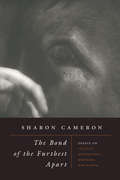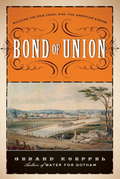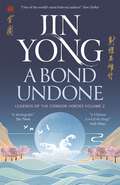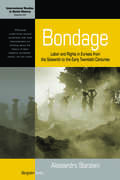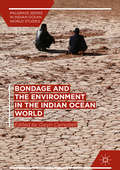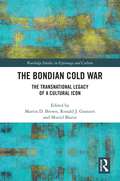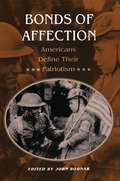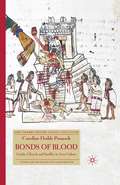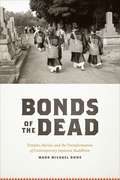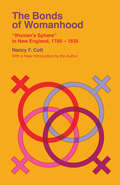- Table View
- List View
The Bond of the Furthest Apart: Essays on Tolstoy, Dostoevsky, Bresson, and Kafka
by Sharon CameronIn the French filmmaker Robert Bresson’s cinematography, the linkage of fragmented, dissimilar images challenges our assumption that we know either what things are in themselves or the infinite ways in which they are entangled. The “bond” of Sharon Cameron’s title refers to the astonishing connections found both within Bresson’s films and across literary works by Tolstoy, Dostoevsky, and Kafka, whose visionary rethinkings of experience are akin to Bresson’s in their resistance to all forms of abstraction and classification that segregate aspects of reality. Whether exploring Bresson’s efforts to reassess the limits of human reason and will, Dostoevsky’s subversions of Christian conventions, Tolstoy’s incompatible beliefs about death, or Kafka’s focus on creatures neither human nor animal, Cameron illuminates how the repeated juxtaposition of disparate, even antithetical, phenomena carves out new approaches to defining the essence of being, one where the very nature of fixed categories is brought into question. An innovative look at a classic French auteur and three giants of European literature, The Bond of the Furthest Apart will interest scholars of literature, film, ethics, aesthetics, and anyone drawn to an experimental venture in critical thought.
The Bond of the Furthest Apart: Essays on Tolstoy, Dostoevsky, Bresson, and Kafka
by Sharon CameronIn the French filmmaker Robert Bresson’s cinematography, the linkage of fragmented, dissimilar images challenges our assumption that we know either what things are in themselves or the infinite ways in which they are entangled. The “bond” of Sharon Cameron’s title refers to the astonishing connections found both within Bresson’s films and across literary works by Tolstoy, Dostoevsky, and Kafka, whose visionary rethinkings of experience are akin to Bresson’s in their resistance to all forms of abstraction and classification that segregate aspects of reality. Whether exploring Bresson’s efforts to reassess the limits of human reason and will, Dostoevsky’s subversions of Christian conventions, Tolstoy’s incompatible beliefs about death, or Kafka’s focus on creatures neither human nor animal, Cameron illuminates how the repeated juxtaposition of disparate, even antithetical, phenomena carves out new approaches to defining the essence of being, one where the very nature of fixed categories is brought into question. An innovative look at a classic French auteur and three giants of European literature, The Bond of the Furthest Apart will interest scholars of literature, film, ethics, aesthetics, and anyone drawn to an experimental venture in critical thought.
The Bond of the Furthest Apart: Essays on Tolstoy, Dostoevsky, Bresson, and Kafka
by Sharon CameronIn the French filmmaker Robert Bresson’s cinematography, the linkage of fragmented, dissimilar images challenges our assumption that we know either what things are in themselves or the infinite ways in which they are entangled. The “bond” of Sharon Cameron’s title refers to the astonishing connections found both within Bresson’s films and across literary works by Tolstoy, Dostoevsky, and Kafka, whose visionary rethinkings of experience are akin to Bresson’s in their resistance to all forms of abstraction and classification that segregate aspects of reality. Whether exploring Bresson’s efforts to reassess the limits of human reason and will, Dostoevsky’s subversions of Christian conventions, Tolstoy’s incompatible beliefs about death, or Kafka’s focus on creatures neither human nor animal, Cameron illuminates how the repeated juxtaposition of disparate, even antithetical, phenomena carves out new approaches to defining the essence of being, one where the very nature of fixed categories is brought into question. An innovative look at a classic French auteur and three giants of European literature, The Bond of the Furthest Apart will interest scholars of literature, film, ethics, aesthetics, and anyone drawn to an experimental venture in critical thought.
Bond of Union: Building the Erie Canal and the American Empire
by Gerard KoeppelIn this elegantly written and far-reaching narrative, acclaimed author Gerard Koeppel tells the astonishing story of the creation of the Erie Canal and the memorable characters who turned a visionary plan into a successful venture. Koeppel's long years of research fill the pages with new findings about the construction of the canal and its enormous impact, providing a unique perspective on America's self perception as an empire destined to expand to the Pacific.
Bond of Union: Building the Erie Canal and the American Empire
by Gerard KoeppelIn this elegantly written and far-reaching narrative, acclaimed author Gerard Koeppel tells the astonishing story of the creation of the Erie Canal and the memorable characters who turned a visionary plan into a successful venture. Koeppel's long years of research fill the pages with new findings about the construction of the canal and its enormous impact, providing a unique perspective on America's self perception as an empire destined to expand to the Pacific.
A Bond Undone: Legends of the Condor Heroes Vol. 2 (Legends of the Condor Heroes #2)
by Jin YongTHE CHINESE "LORD OF THE RINGS" - NOW IN ENGLISH FOR THE FIRST TIME.THE SERIES EVERY CHINESE READER HAS BEEN ENJOYING FOR DECADES - 100 MILLION COPIES SOLD.In the Jin capital of Zhongdu, Guo Jing learns the truth of his father's death and finds he is now betrothed, against his will, to two women. Neither of them is his sweetheart Lotus Huang.Torn between following his heart and fulfilling his filial duty, he journeys through the country of his parents with Lotus, encountering mysterious martial heroes and becoming drawn into the struggle for the supreme martial text, the Nine Yin Manual. But his past is catching up with him. The widow of an evil man he accidentally killed as a child has tracked him down, intent on revenge. Meanwhile, his true parentage at last revealed, Yang Kang, the young prince Guo Jing must face in the Garden of the Eight Drunken Immortals, is forced to choose his destiny. Will he continue to enjoy the life of wealth and privilege afforded to him by the invader of his homeland, or give up all he has known to avenge his parents?Translated from the Chinese by Gigi Chang
Bondage: Labor and Rights in Eurasia from the Sixteenth to the Early Twentieth Centuries (International Studies in Social History #24)
by Alessandro StanzianiFor the first time, this book provides the global history of labor in Central Eurasia, Russia, Europe, and the Indian Ocean between the sixteenth and the twentieth centuries. It contests common views on free and unfree labor, and compares the latter to many Western countries where wage conditions resembled those of domestic servants. This gave rise to extreme forms of dependency in the colonies, not only under slavery, but also afterwards in form of indentured labor in the Indian Ocean and obligatory labor in Africa. Stanziani shows that unfree labor and forms of economic coercion were perfectly compatible with market development and capitalism, proven by the consistent economic growth that took place all over Eurasia between the seventeenth and the nineteenth centuries. This growth was labor intensive: commercial expansion, transformations in agriculture, and the first industrial revolution required more labor, not less. Finally, Stanziani demonstrates that this world did not collapse after the French Revolution or the British industrial revolution, as is commonly assumed, but instead between 1870 and 1914, with the second industrial revolution and the rise of the welfare state.
Bondage and the Environment in the Indian Ocean World (Palgrave Series in Indian Ocean World Studies)
by Gwyn CampbellMonsoon rains, winds, and currents have shaped patterns of production and exchange in the Indian Ocean world (IOW) for centuries. Consequently, as this volume demonstrates, the environment has also played a central role in determining the region’s systems of bondage and human trafficking. Contributors trace intricate links between environmental forces, human suffering, and political conditions, examining how they have driven people into servile labour and shaped the IOW economy. They illuminate the complexities of IOW bondage with case studies, drawn chiefly from the mid-eighteenth century, on Sudan, Cape Colony, Réunion, China, and beyond, where chattel slavery (as seen in the Atlantic world) represented only one extreme of a wide spectrum of systems of unfree labour. The array of factors examined here, including climate change, environmental disaster, disease, and market forces, are central to IOW history—and to modern-day forms of human bondage.
Bonded Heart
by Jane JacksonA tale of love and hardship set in wild and beautiful 19th century Cornwall. Born into a once-respectable family, circumstances have reduced Roz Trevaskis to working at the local inn. In order to pay the fines incurred through her alcoholic mother’s drunken behaviour, Roz has put herself in debt to some unpleasant people, and has reluctantly turned to smuggling. When her half-brother, Tom, is offered a job as an apprentice on the estate of the local JP, Branoc Casvellan, Roz realises this is an opportunity to dig her family out of trouble. Then Casvellan's brother catches smallpox, and it falls to Roz to nurse him – bringing her into close contact with her handsome employer. But how will Casvellan – and his family – react when the truth about Roz's life comes out?
Bonded Histories: Genealogies of Labor Servitude in Colonial India (PDF)
by Gyan PrakashTo the modern world, the notions that freedom is an innate condition of human beings and that money possesses the power to bind people appear as natural facts. Bonded Histories: Genealogies of Labor Servitude in Colonial India traces the historical processes by which these notions became established as dominant discourses in India during colonial rule and continued into post-colonial India. Gyan Prakash locates the formulation of these discourses in the history of bonded labor in southern Bihar. He focuses on the emergence and subsequent transformation in the relationship of reciprocal power and dependence between landlords and laborers. The author explores the way in which these transformations were connected with broader shifts in the political economy of this part of the subcontinent; with the Changing structures of agricultural production, land tenure and revenue demand; with local social hierarchies and the ideology of castes; and with Hindu cosmologies, spirit cults and their articulation in ritual practices. In Bonded Histories: Genealogies of Labor Servitude in Colonial India, Gyan Prakash combines a sophisticated theoretical analysis with evidence from archival records, village documents and oral testimonies to present an original and compelling view of the changing relationship of bondage. The book will be of interest to historians, anthropologists and contemporary social theorists.
Bondi Beach: Representations of an Iconic Australian
by Douglas BoothBondi Beach is a history of an iconic place. It is a big history of geological origins, management by Aboriginal people, environmental despoliation by white Australians, and the formation of beach cultures. It is also a local history of the name Bondi, the origins of the Big Rock at Ben Buckler, the motives of early land holders, the tragedy known as Black Sunday, the hostilities between lifesavers and surfers, and the hullabaloos around the Pavilion. Pointing to a myriad of representations, author Douglas Booth shows that there is little agreement about the meaning of Bondi. Booth resolves these representations with a fresh narrative that presents the beach’s perspective of a place under siege. Booth’s creative narrative conveys important lessons about our engagement with the physical world.
The Bondian Cold War: The Transnational Legacy of a Cultural Icon (Routledge Studies in Espionage and Culture)
by Martin D. BrownJames Bond, Ian Fleming’s irrepressible and ubiquitous ‘spy,’ is often understood as a Cold Warrior, but James Bond’s Cold War diverged from the actual global conflict in subtle but significant ways.That tension between the real and fictional provides perspectives into Cold War culture transcending ideological and geopolitical divides. The Bondiverse is complex and multi-textual, including novels, films, video games, and even a comic strip, and has also inspired an array of homages, copies, and competitors. Awareness of its rich possibilities only becomes apparent through a multi-disciplinary lens.The desire to consider current trends in Bondian studies inspired a conference entitled ‘The Bondian Cold War,’ convened at Tallinn University, Estonia in June 2019. Conference participants, drawn from three continents and multiple disciplines – film studies, history, intelligence studies, and literature, as well as intelligence practitioners – offered papers on the literary and cinematic aspects of the ‘spy’, discussed fact versus fiction in the Bond canon, went in search of a global Bond, and pondered gender and sexuality across the Bondiverse.This volume of essays inspired by that conference, suitable for students, researchers, and anyone interested in Cold War culture, makes vital contributions to understanding Bond as a global phenomenon, across traditional divisions of East and West, and beyond the end of the Cold War from which he emerged.
The Bondian Cold War: The Transnational Legacy of a Cultural Icon (Routledge Studies in Espionage and Culture)
by Martin D. Brown Ronald J. Granieri Muriel BlaiveJames Bond, Ian Fleming’s irrepressible and ubiquitous ‘spy,’ is often understood as a Cold Warrior, but James Bond’s Cold War diverged from the actual global conflict in subtle but significant ways.That tension between the real and fictional provides perspectives into Cold War culture transcending ideological and geopolitical divides. The Bondiverse is complex and multi-textual, including novels, films, video games, and even a comic strip, and has also inspired an array of homages, copies, and competitors. Awareness of its rich possibilities only becomes apparent through a multi-disciplinary lens.The desire to consider current trends in Bondian studies inspired a conference entitled ‘The Bondian Cold War,’ convened at Tallinn University, Estonia in June 2019. Conference participants, drawn from three continents and multiple disciplines – film studies, history, intelligence studies, and literature, as well as intelligence practitioners – offered papers on the literary and cinematic aspects of the ‘spy’, discussed fact versus fiction in the Bond canon, went in search of a global Bond, and pondered gender and sexuality across the Bondiverse.This volume of essays inspired by that conference, suitable for students, researchers, and anyone interested in Cold War culture, makes vital contributions to understanding Bond as a global phenomenon, across traditional divisions of East and West, and beyond the end of the Cold War from which he emerged.
Bonds of Affection: Americans Define Their Patriotism
by John BodnarDuring the Civil War, Walt Whitman described his admiration for the Union soldiers' loyalty to the ideal of democracy. His argument, that this faith bonded Americans to their nation, has received little critical attention, yet today it raises increasingly relevant questions about American patriotism in the face of growing nationalist sentiment worldwide. Here a group of scholars explores the manner in which Americans have discussed and practiced their patriotism over the past two hundred years. Their essays investigate, for example, the extent to which the promise of democracy has explained citizen loyalty, what other factors--such as devotion to home and family--have influenced patriotism, and how patriotism has often served as a tool to maintain the power of a dominant group and to obscure internal social ills. This volume examines the use of patriotic language and symbols in building unity in the early republic, rebuilding the nation after the Civil War, and sustaining loyalty in an increasingly diverse society. Continuing through the World Wars to the Clinton presidency, the essay topics range from multiculturalism to reactions toward masculine power. In addition to the editor, the contributors include Cynthia M. Koch, Cecilia Elizabeth O'Leary, Andrew Neather, Stuart McConnell, Gaines M. Foster, Kimberly Jensen, David Glassberg and J. Michael Moore, Lawrence R. Samuel, Robert B. Westbrook, Wendy Kozol, George Lipsitz, Barbara Truesdell, Robin Wagner-Pacifici, and William B. Cohen.
Bonds of Blood: Gender, Lifecycle, and Sacrifice in Aztec Culture (Early Modern History: Society and Culture)
by Caroline Dodds PennockThe history of the Aztecs has been haunted by the spectre of human sacrifice. Reinvesting the Aztecs with a humanity frequently denied to them, and exploring their spectacular religious violence as a comprehensible element of life, this book integrates a fresh interpretation of gender with an innovative study of the everyday life of the Aztecs.
The bonds of family: Slavery, commerce and culture in the British Atlantic world (Studies in Imperialism #172)
by Katie DoningtonMoving between Britain and Jamaica this book reconstructs the world of commerce, consumption and cultivation sustained through an extended engagement with the business of slavery. Transatlantic slavery was both shaping of and shaped by the dynamic networks of family that established Britain’s Caribbean empire. Tracing the activities of a single extended family – the Hibberts – this book explores how slavery impacted on the social, cultural, economic and political landscape of Britain. It is a history of trade, colonisation, enrichment and the tangled web of relations that gave meaning to the transatlantic world. The Hibberts’s trans-generational story imbricates the personal and the political, the private and the public, the local and the global. It is both the intimate narrative of a family and an analytical frame through which to explore Britain’s history and legacies of slavery.
The bonds of family: Slavery, commerce and culture in the British Atlantic world (Studies in Imperialism #172)
by Katie DoningtonMoving between Britain and Jamaica this book reconstructs the world of commerce, consumption and cultivation sustained through an extended engagement with the business of slavery. Transatlantic slavery was both shaping of and shaped by the dynamic networks of family that established Britain’s Caribbean empire. Tracing the activities of a single extended family – the Hibberts – this book explores how slavery impacted on the social, cultural, economic and political landscape of Britain. It is a history of trade, colonisation, enrichment and the tangled web of relations that gave meaning to the transatlantic world. The Hibberts’s trans-generational story imbricates the personal and the political, the private and the public, the local and the global. It is both the intimate narrative of a family and an analytical frame through which to explore Britain’s history and legacies of slavery.
The Bonds of Inequality: Debt and the Making of the American City
by Destin JenkinsIndebtedness, like inequality, has become a ubiquitous condition in the United States. Yet few have probed American cities’ dependence on municipal debt or how the terms of municipal finance structure racial privileges, entrench spatial neglect, elide democratic input, and distribute wealth and power. In this passionate and deeply researched book, Destin Jenkins shows in vivid detail how, beyond the borrowing decisions of American cities and beneath their quotidian infrastructure, there lurks a world of politics and finance that is rarely seen, let alone understood. Focusing on San Francisco, The Bonds of Inequality offers a singular view of the postwar city, one where the dynamics that drove its creation encompassed not only local politicians but also banks, credit rating firms, insurance companies, and the national municipal bond market. Moving between the local and the national, The Bonds of Inequality uncovers how racial inequalities in San Francisco were intrinsically tied to municipal finance arrangements and how these arrangements were central in determining the distribution of resources in the city. By homing in on financing and its imperatives, Jenkins boldly rewrites the history of modern American cities, revealing the hidden strings that bind debt and power, race and inequity, democracy and capitalism.
Bonds of the Dead: Temples, Burial, and the Transformation of Contemporary Japanese Buddhism (Buddhism and Modernity)
by Mark Michael RoweDespite popular images of priests seeking enlightenment in snow-covered mountain temples, the central concern of Japanese Buddhism is death. For that reason, Japanese Buddhism’s social and economic base has long been in mortuary services—a base now threatened by public debate over the status, treatment, and location of the dead. Bonds of the Dead explores the crisis brought on by this debate and investigates what changing burial forms reveal about the ways temple Buddhism is perceived and propagated in contemporary Japan. Mark Rowe offers a crucial account of how religious, political, social, and economic forces in the twentieth century led to the emergence of new funerary practices in Japan and how, as a result, the care of the dead has become the most fundamental challenge to the continued existence of Japanese temple Buddhism. Far from marking the death of Buddhism in Japan, Rowe argues, funerary Buddhism reveals the tradition at its most vibrant. Combining ethnographic research with doctrinal considerations, this is a fascinating book for anyone interested in Japanese society and religion.
Bonds of the Dead: Temples, Burial, and the Transformation of Contemporary Japanese Buddhism (Buddhism and Modernity)
by Mark Michael RoweDespite popular images of priests seeking enlightenment in snow-covered mountain temples, the central concern of Japanese Buddhism is death. For that reason, Japanese Buddhism’s social and economic base has long been in mortuary services—a base now threatened by public debate over the status, treatment, and location of the dead. Bonds of the Dead explores the crisis brought on by this debate and investigates what changing burial forms reveal about the ways temple Buddhism is perceived and propagated in contemporary Japan. Mark Rowe offers a crucial account of how religious, political, social, and economic forces in the twentieth century led to the emergence of new funerary practices in Japan and how, as a result, the care of the dead has become the most fundamental challenge to the continued existence of Japanese temple Buddhism. Far from marking the death of Buddhism in Japan, Rowe argues, funerary Buddhism reveals the tradition at its most vibrant. Combining ethnographic research with doctrinal considerations, this is a fascinating book for anyone interested in Japanese society and religion.
Bonds of the Dead: Temples, Burial, and the Transformation of Contemporary Japanese Buddhism (Buddhism and Modernity)
by Mark Michael RoweDespite popular images of priests seeking enlightenment in snow-covered mountain temples, the central concern of Japanese Buddhism is death. For that reason, Japanese Buddhism’s social and economic base has long been in mortuary services—a base now threatened by public debate over the status, treatment, and location of the dead. Bonds of the Dead explores the crisis brought on by this debate and investigates what changing burial forms reveal about the ways temple Buddhism is perceived and propagated in contemporary Japan. Mark Rowe offers a crucial account of how religious, political, social, and economic forces in the twentieth century led to the emergence of new funerary practices in Japan and how, as a result, the care of the dead has become the most fundamental challenge to the continued existence of Japanese temple Buddhism. Far from marking the death of Buddhism in Japan, Rowe argues, funerary Buddhism reveals the tradition at its most vibrant. Combining ethnographic research with doctrinal considerations, this is a fascinating book for anyone interested in Japanese society and religion.
Bonds of the Dead: Temples, Burial, and the Transformation of Contemporary Japanese Buddhism (Buddhism and Modernity)
by Mark Michael RoweDespite popular images of priests seeking enlightenment in snow-covered mountain temples, the central concern of Japanese Buddhism is death. For that reason, Japanese Buddhism’s social and economic base has long been in mortuary services—a base now threatened by public debate over the status, treatment, and location of the dead. Bonds of the Dead explores the crisis brought on by this debate and investigates what changing burial forms reveal about the ways temple Buddhism is perceived and propagated in contemporary Japan. Mark Rowe offers a crucial account of how religious, political, social, and economic forces in the twentieth century led to the emergence of new funerary practices in Japan and how, as a result, the care of the dead has become the most fundamental challenge to the continued existence of Japanese temple Buddhism. Far from marking the death of Buddhism in Japan, Rowe argues, funerary Buddhism reveals the tradition at its most vibrant. Combining ethnographic research with doctrinal considerations, this is a fascinating book for anyone interested in Japanese society and religion.
Bonds of the Dead: Temples, Burial, and the Transformation of Contemporary Japanese Buddhism (Buddhism and Modernity)
by Mark Michael RoweDespite popular images of priests seeking enlightenment in snow-covered mountain temples, the central concern of Japanese Buddhism is death. For that reason, Japanese Buddhism’s social and economic base has long been in mortuary services—a base now threatened by public debate over the status, treatment, and location of the dead. Bonds of the Dead explores the crisis brought on by this debate and investigates what changing burial forms reveal about the ways temple Buddhism is perceived and propagated in contemporary Japan. Mark Rowe offers a crucial account of how religious, political, social, and economic forces in the twentieth century led to the emergence of new funerary practices in Japan and how, as a result, the care of the dead has become the most fundamental challenge to the continued existence of Japanese temple Buddhism. Far from marking the death of Buddhism in Japan, Rowe argues, funerary Buddhism reveals the tradition at its most vibrant. Combining ethnographic research with doctrinal considerations, this is a fascinating book for anyone interested in Japanese society and religion.
Bonds of the Dead: Temples, Burial, and the Transformation of Contemporary Japanese Buddhism (Buddhism and Modernity)
by Mark Michael RoweDespite popular images of priests seeking enlightenment in snow-covered mountain temples, the central concern of Japanese Buddhism is death. For that reason, Japanese Buddhism’s social and economic base has long been in mortuary services—a base now threatened by public debate over the status, treatment, and location of the dead. Bonds of the Dead explores the crisis brought on by this debate and investigates what changing burial forms reveal about the ways temple Buddhism is perceived and propagated in contemporary Japan. Mark Rowe offers a crucial account of how religious, political, social, and economic forces in the twentieth century led to the emergence of new funerary practices in Japan and how, as a result, the care of the dead has become the most fundamental challenge to the continued existence of Japanese temple Buddhism. Far from marking the death of Buddhism in Japan, Rowe argues, funerary Buddhism reveals the tradition at its most vibrant. Combining ethnographic research with doctrinal considerations, this is a fascinating book for anyone interested in Japanese society and religion.
The Bonds of Womanhood: "Woman's Sphere" in New England, 1780-1835 (Veritas Paperbacks)
by Nancy F. CottThis Veritas edition of Nancy Cott’s acclaimed study includes a new introduction by the author, situating the work for a new generation of readers. “Elegant and convincing. . . . Better than any other work available, The Bonds of Womanhood describes both the classic attitudes of the nineteenth century toward women and the opposition to the oppression of women in the historical context from which they grew.”—Willie Lee Rose, New York Review of Books “A lovely, gentle, scholarly, and valuable book.”—Doris Grumbach, New York Times Book Review
